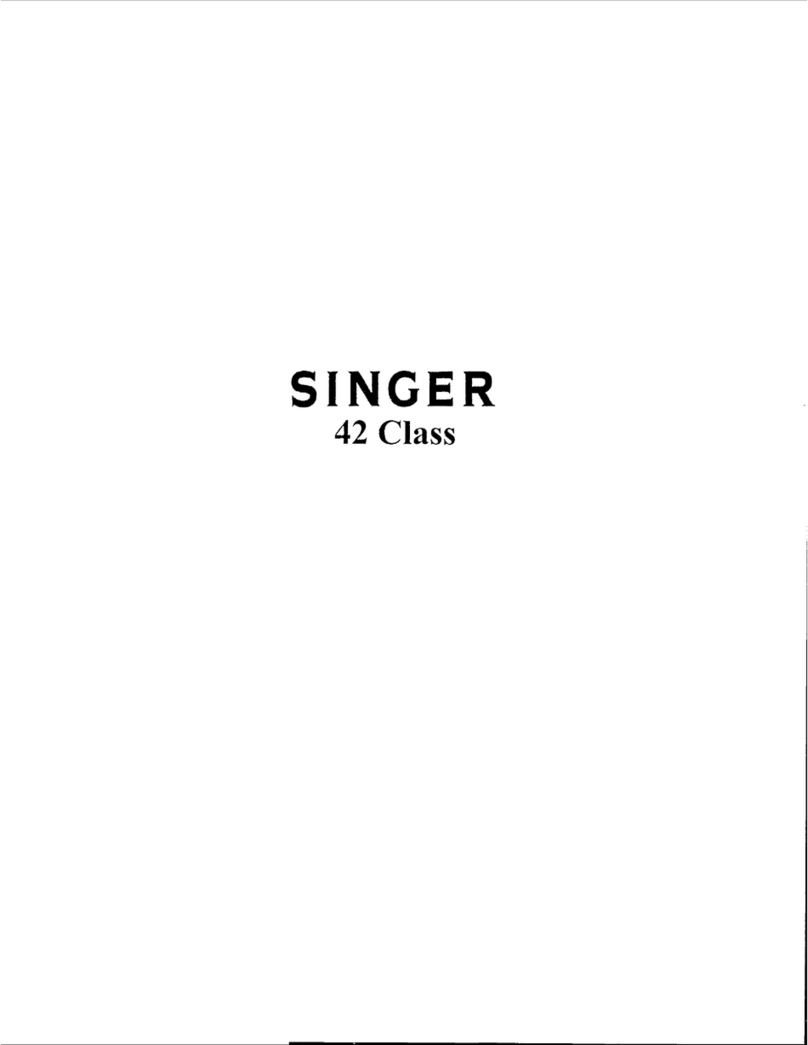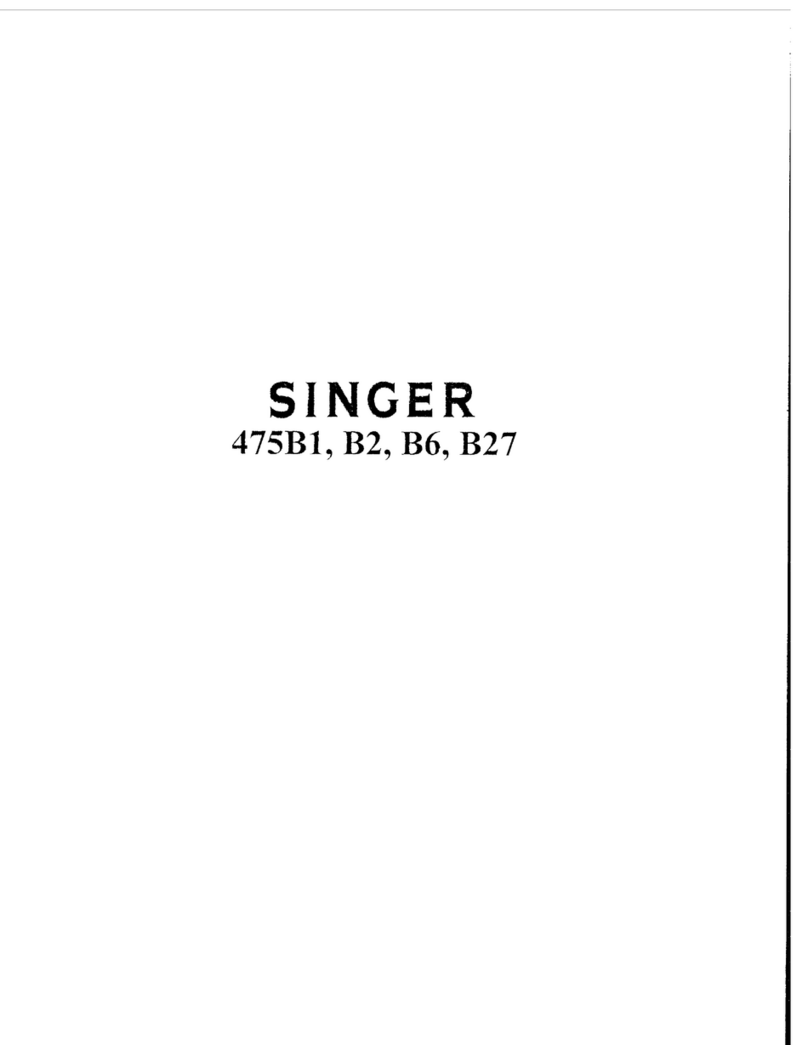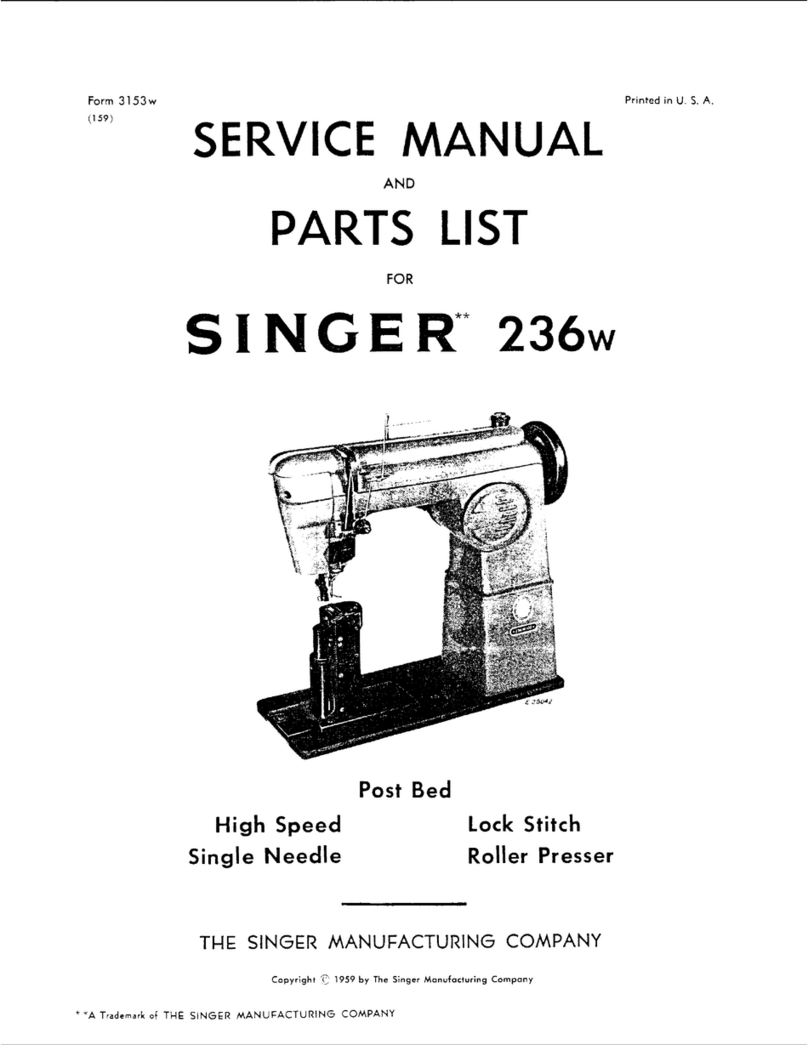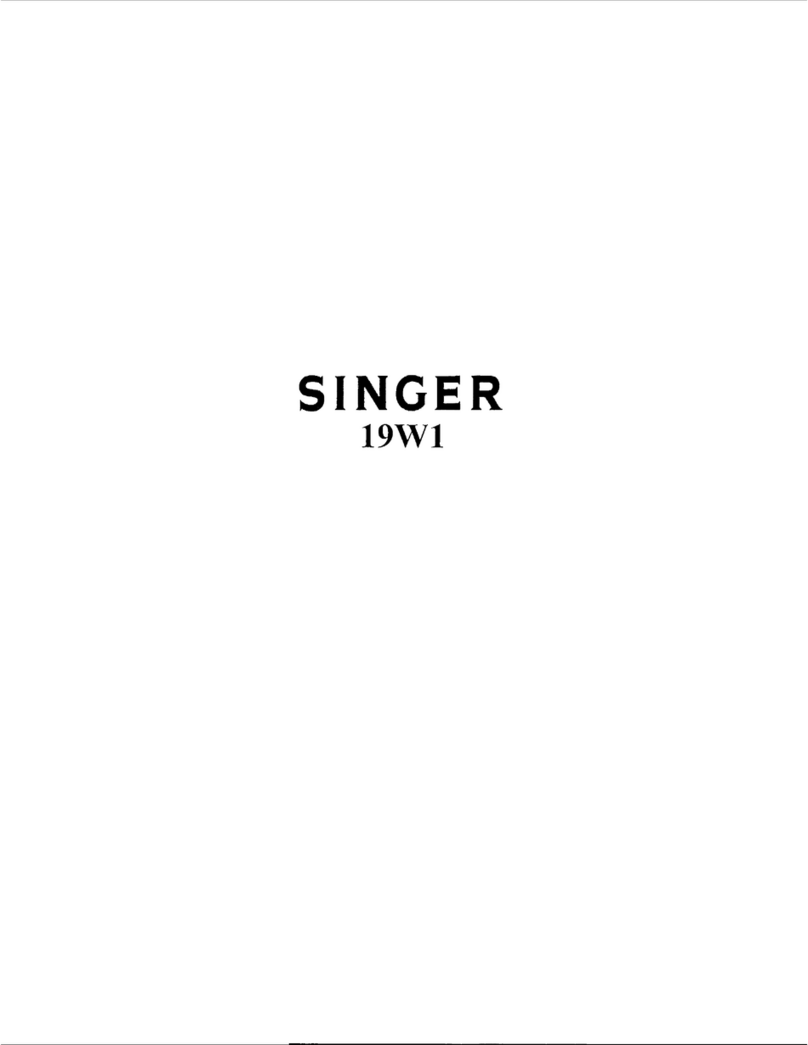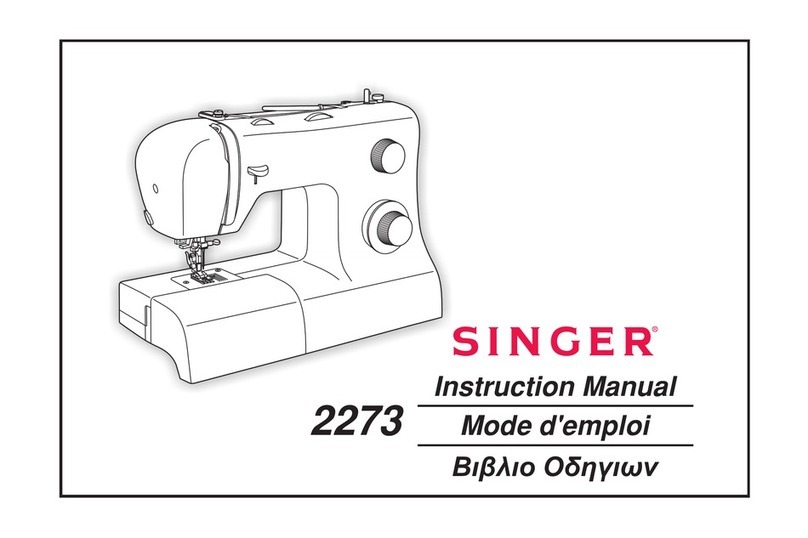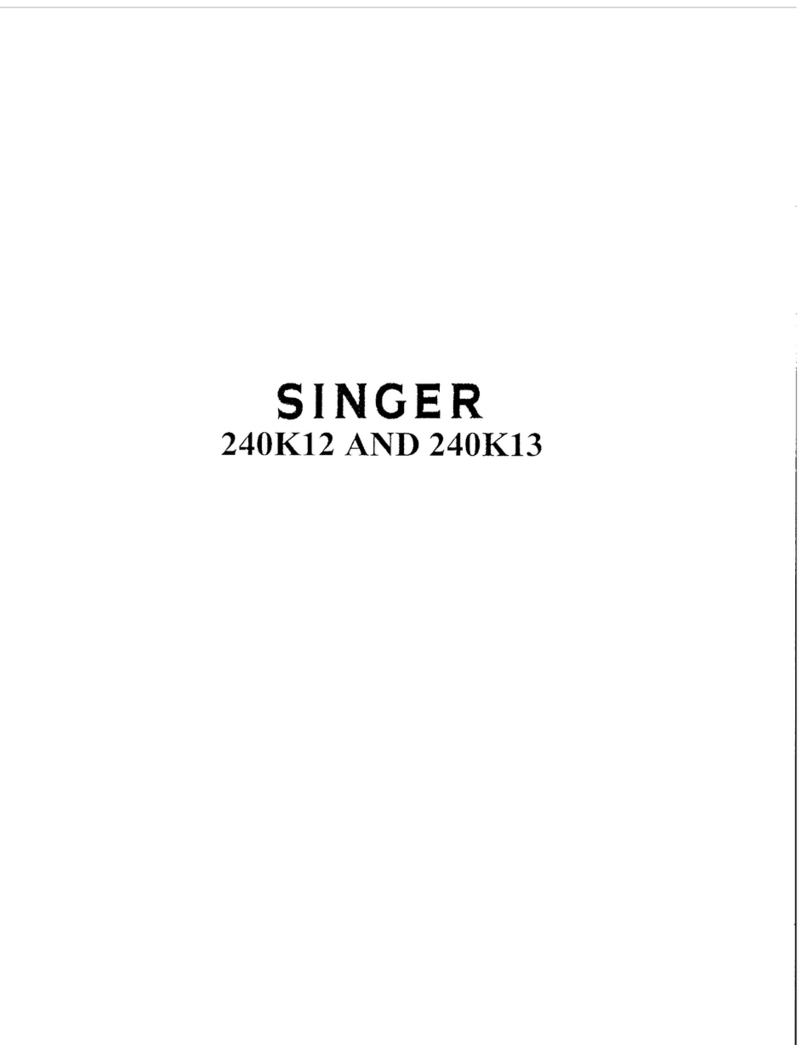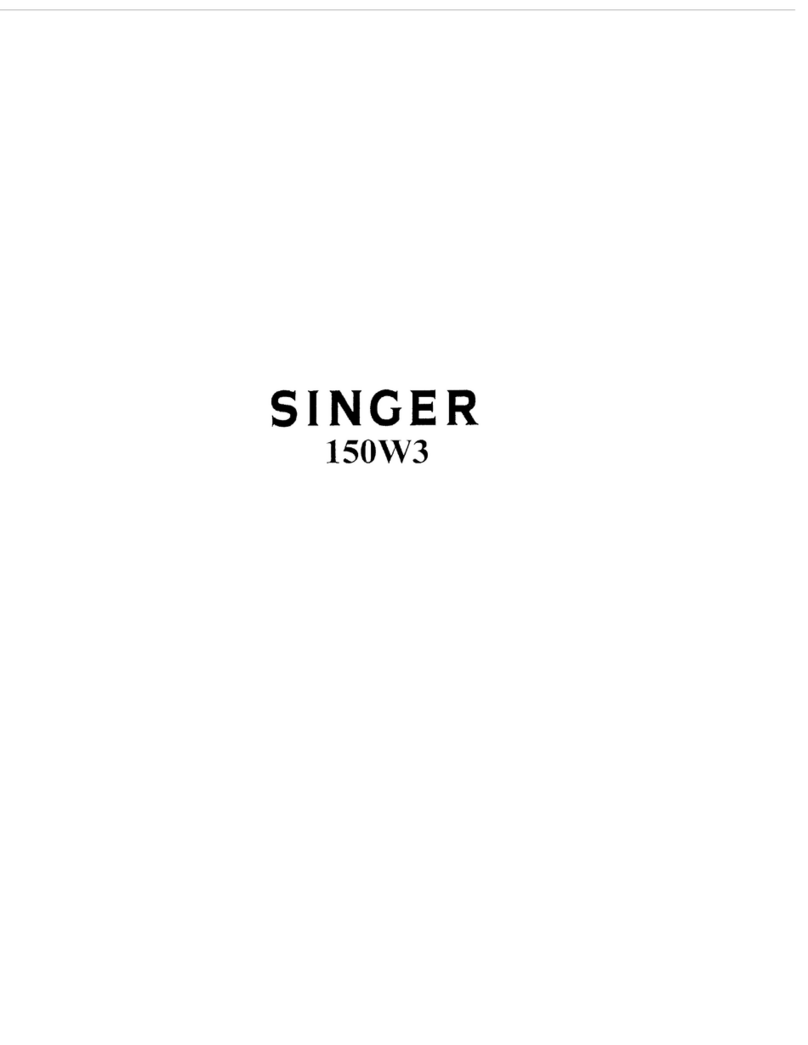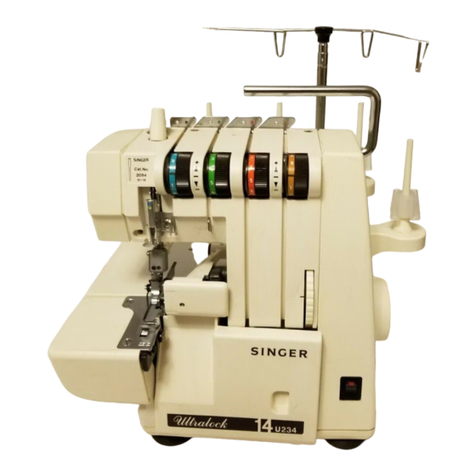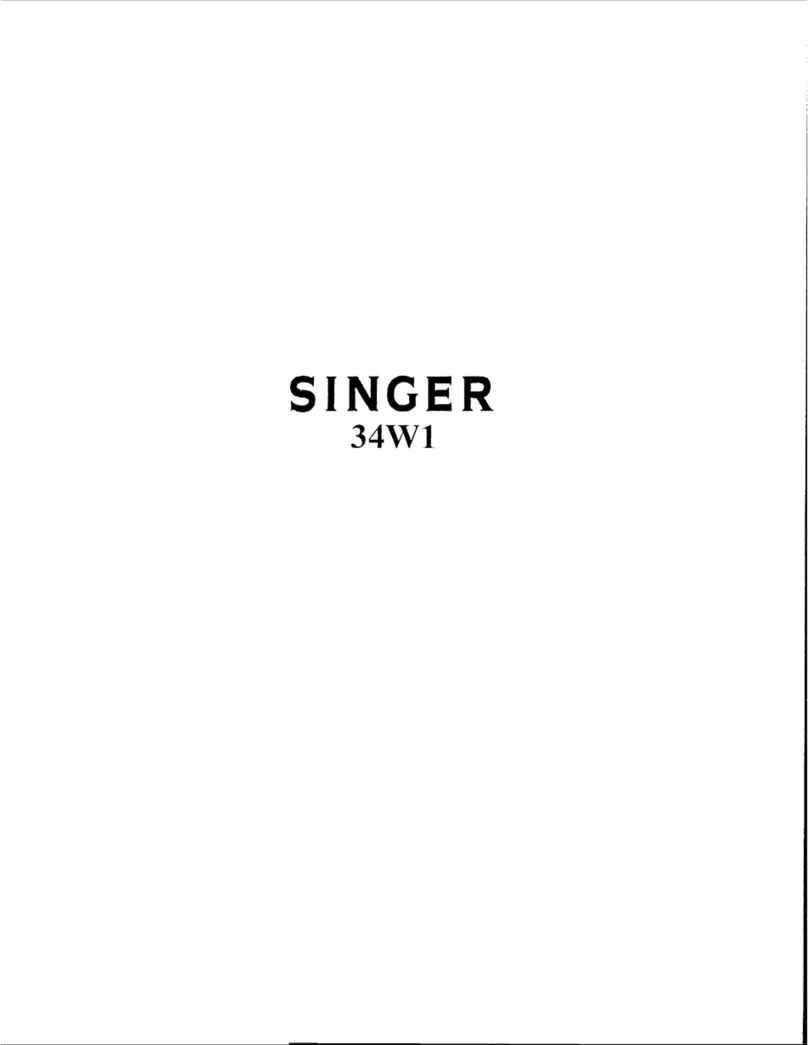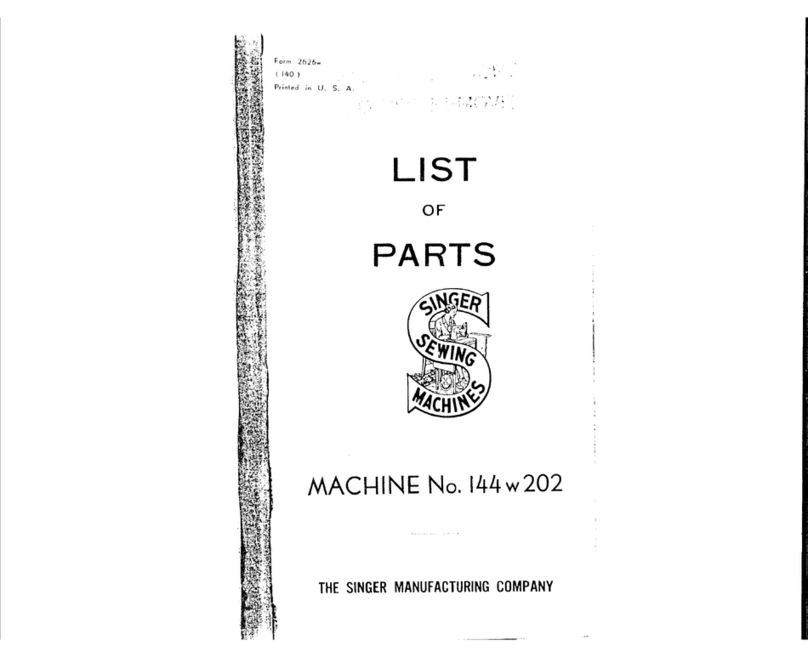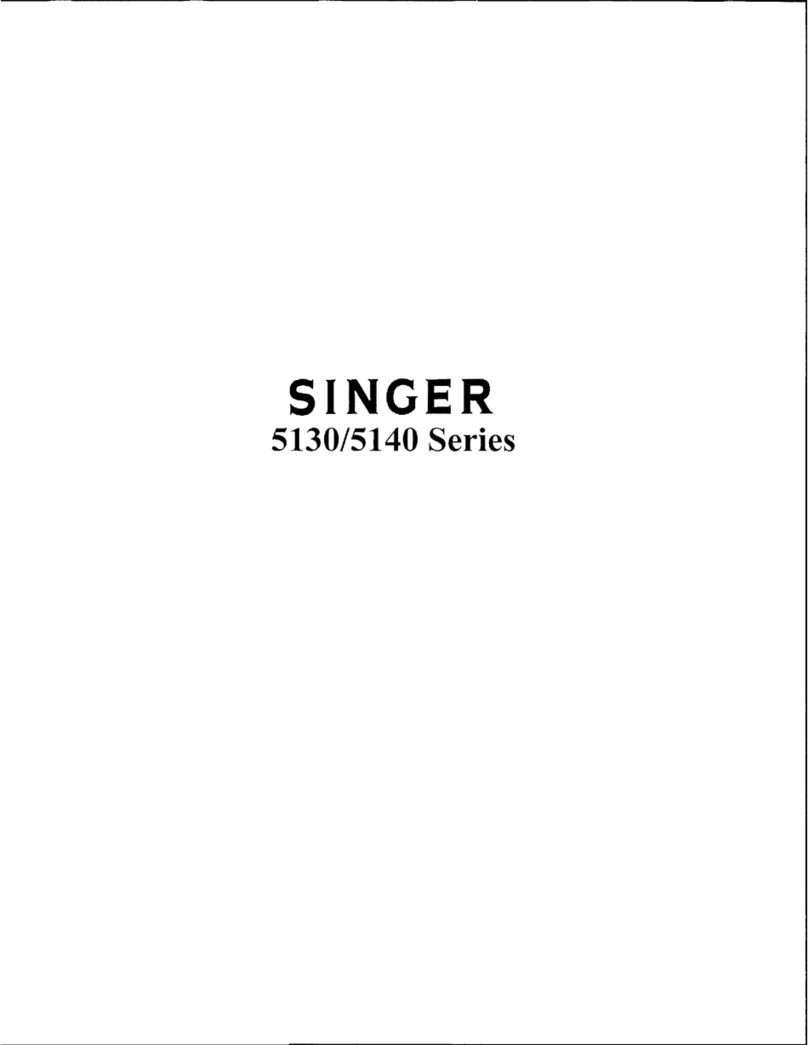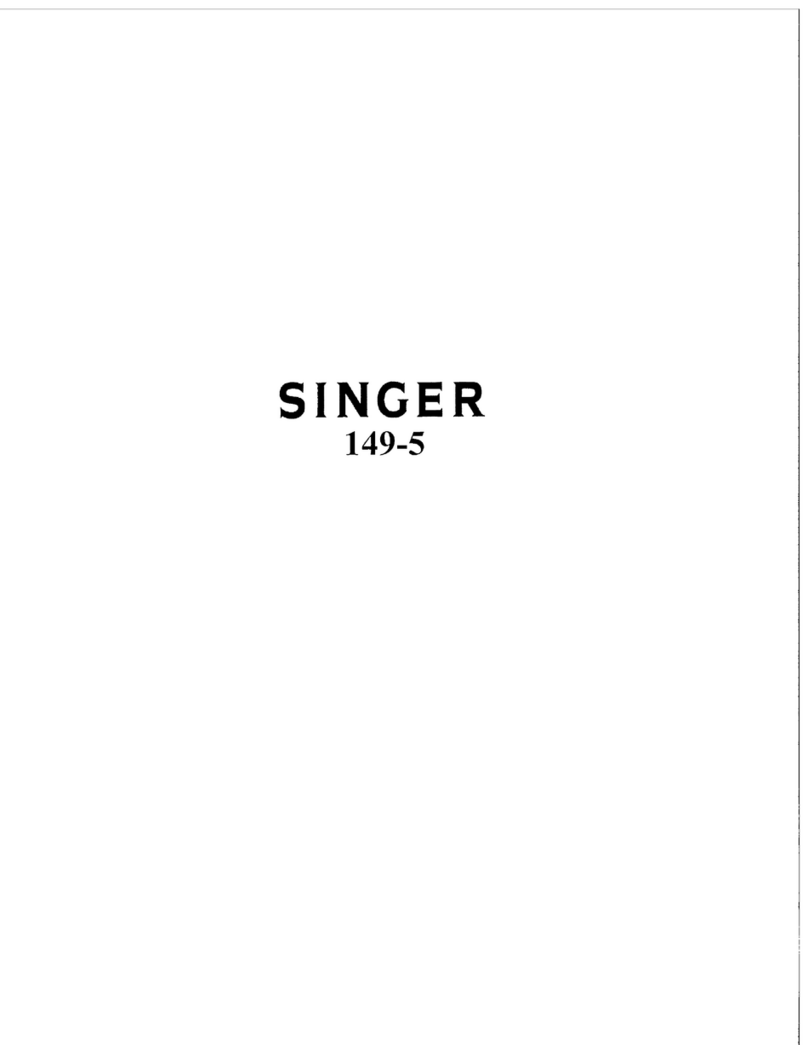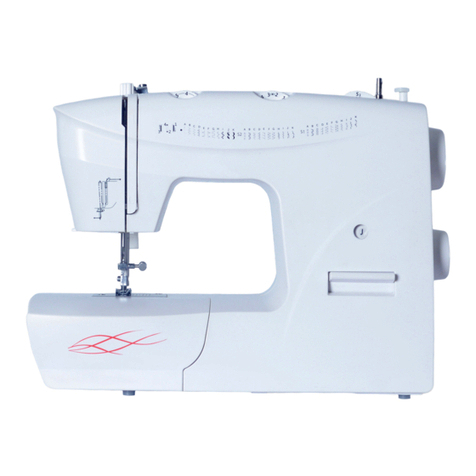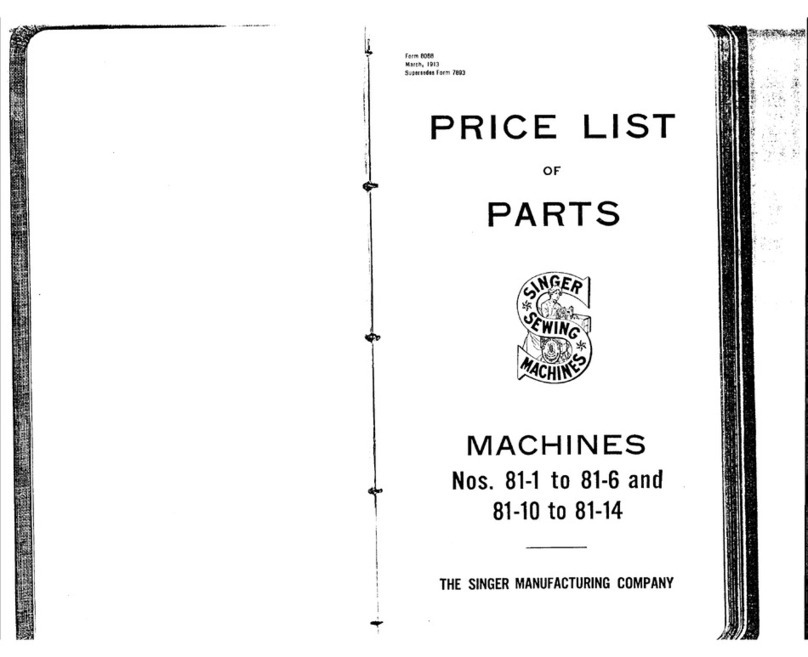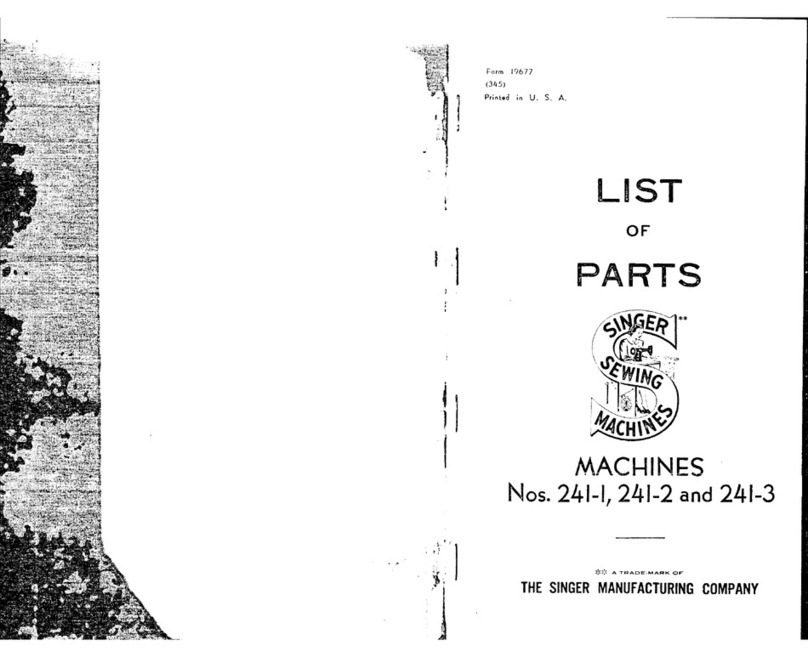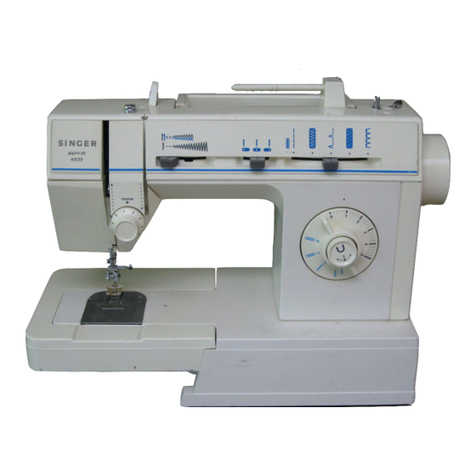8.
SpulengehSuse
58
herausnehmen.
9.
GreUer
mil
alien
Elhzelhelten
von
anhaftendem
Sdimutz
and
Fadenresten
relnlgen.
10. Belm Zusammenbau alle LaufflSchen mil einem olgetrSnktem Lappen
anfeuchten.
11. Nase SSdes Spulengehauses muBunbedlngt in Aussparung der Stlch-
platten-Unterseite
fassen.
12.
Schrauben
festdrehen,
SpulengehSuse
muB sich dabel lelcht Im Grelfer
drehen.
Rutschkupplung
DieRutschkupplunghat die Aufgabe, die bet liartem Fadenelnschlag auf-
tretenden
Schlage
aufzufangen,
und
die
Telle
vor Bruch zu
slchern.
Glelch-
zeltlg
verhlndert
sle
ein
gewaltsames
Verstellen
des
Grelfers.
1.
HIndernIs
entfernen.
2.
Knopf
11,
Abb.
1,
nIederdrOcken.
3.
Handrad
drehen,
bis Kupplung
wleder
elnrastet.
4. Der Federdruck der Kupplung kann bel VerwendungstSrkerer FSden Oder
NShmaterlal durch Drenen der auf dem unteren Zahnformrlemenrad (unter
dem
Zahnformriemen)
sitzenden
Schraube
verstSrkt
werden.
Es Ist zweckmSBIg
dlese
Arbeit
von
einem
Fachmechanlker
ausfOhren zu
lessen.
Sollten noch Irgendwelche Unklarhelten
bestehen,
bitte Vertreter Oder Fach-
berater
anfordern.
Bel Ruckfragen im Werk bItte
angeben:
1.
Lleferdatum
2.
Klassenbezelchnung
}.
Obertellnummer.
Directions
for
use
^lease study these operating Instructions carefully and observe the recom-
nendatlons.
fhe
following
text applies onlyto the basic operation ofthe
SINGER
144
A.
f operation of the sub-classes differsfromthat of the basic design, please
consult the supplementary Instructions SINGER 145A. The additional or new
llustratlons referring to the text will be found on the reverse of this sheet,
'lease
note
I
n Oderto extend the lifeof the machine, the sewing speed should be reduced
n
the
following
cases:
.
during
the
runnlng-ln
period,
I In
the
case
of thick
material,
I.
when
In
continuous
use,
-.
when
using
long
stitches,
>.
when
difficult
processes
are
Involved.
Components
144 A 304
1
Take-up
lever
2
Needle
thread
tension
3
Thread
guide
4Presser foot pressure adjusting
screw
5
Thread
guide
pin
6 Oil
tank
(for
needle
thread)
7
Side
handwheel
(only with
sub-classes 144A304;144A305)
8 Stop lever (for presser foot
high position)
9 Stitch
length
adjusting knob
0
Handwheel
1
Release
clutch
button
12
RIghthand
slide
13
Throat
plate
14
Lefthand
slide
15
Fabric
feed
loot
16
Upper
feed
loot
17
Upper
feed
foot
set
screw
18
Thread
guide
19 Thread take-up lever
20
Thread
guide
21
Head
cover
set
screw
22 Thread guide hook
23
Thread
guide
hole
24
Needle
set
screw
25
Fabric
lead
foot
set
screw
inpacking
1.
Check
the
packaging
fordamageInthe presenceofthecarrier.
2. Checksewing machine,stand and accessories for any possible transoort
damage.
3. Immediately notifyany damage in the presence of the carrier,
ssembling
1. Screw the sewing machineonto the assembled special stand or fit it in the
hinges screwed Intothe table plate.
2.
Fitthe top section support 30,fig. 2.
3. Screw on the spool holder 32and the power winder 31.
t. Fitthe Vee-beitontothe
handwheel
and motorpullles.
Byswingingthe motortightenthe Vee-beltuntilItcan be compressed In
the middle by appr. 15 mm (Vi").
leaning
and
oiling
1. Slacken the head cover screw 21,fig. 1.
2.
Remove
the
head
cover.
3.
Slacken the throat plate screws and remove the throat plate 13.
I.
Fit
slides
14
and
12.
>.
Using a clean cloth remove anti-corrosion grease and any dirt from all
components.
1.
Oil all points indicated by arrows Infigs.
3,4
and 9.
'. Onlyuse our resin and acid free sewing machineoil
MR3
(a fewdrops
suffice).
nreading
the
needle
thread
3SS
the needle thread fromthe reel throughthe thread guide holes Inthe
)ool
holder
. fromfrontto rearthroughthe hole33,fig.5
(when
usingneitheroiled nor
soaped thread) or through the hole 34(smallfig. 5)underneath the felt and
the slot 38(when using oiled or soaped thread) - screw 37permits
regulating the pressure on the needle thread
-,
i upwards through the righthand hole of the thread guide 3.
downwardsthrough the lefthandhole of the threadgulde 3,
. around to the left between the discs of the needle thread tension 2
.around to the right Into the thread reel 38,
.
over
the
hook
22,
. Into
the
thread
take-up
lever
19,
. through the righthandside of the thread guide 20,
. fromrightto leftthroughthe top eyeofthe take-uplever1
(with
take-up
lover In Its highest position),
. through the lefthandside of the thread guide 20,
.
through
the
thread
guide
18,
.
through
the
thread
guide
hole
23,
and
.
from
feftto rightapprox.8 cm
(3")
throughthe needleeye.
Needle
and
thread
1. Only
use
needle
system
7x23.
2. Rule for
needle
gauge:
Ifthe thread jams in the long groove, use a thicker needle;
ifthe thread has too much clearance In the long groove, usa a thinner
needle.
3.
Match
needle
thread
to
thickness
of
material
to
be
sewn.
4. The
bobbin
thread
should
be
thinner
or
softer
than
the
needle
thread.
5.
Oiled
thread:
Ifoiled needle thread is to be used forsewing,filloil
tank.S2,
fig.5,
with resin and acid free oil. If, In addition, oiled bobbin thread is to be
used, oil
should
be dripped
onto
the full bobbin until the thread has
been
saturated,
or
the
bobbin
should
be Immersed In an oINIIIed
container.
6.
Soaped
thread:
Forsewinghard materials
which
mustnotshowoilstains, pass the thread
through the oil tank filled with liquid soap. Soaped thread reduces the
depositing
of
adhesive
substances.
Replacing
the
needle
1. Moveneedle bar Into Its highest position (byturning the handwheel 10
towards yourself or the
side
handwheel 7 to the left).
2. Slacken
screw
24, fig. 1.
3. Withdraw
needle
downwards
from the
needle
bar.
4. Insertthe newneedle as high as possible, withthe longgroovefacing
to
the
left.
"
Replacing
the
presser
foot
1. Moveneedle bar into Its highest position (byturning the handwheel 10
towardsyourselfor the side
handwheel
7to the left),
2. Depress treadle 41,fig. 2, swing lever 8 forwards. The fabric feed foot Is
now arrested and remains In Its position.
3. Slackenscrew 17(or
25),
fig.1,and removethe correspondingpresser foot.
4.
Secure
the
new
presser
foot in the inverse
order.
5. Depresstreadle 41,movelever8,fig.1, to the rightand release treadle.
Removing
the
bobbin
1.
Move
needle bar IntoIts highest position (byturning the handwheel10
towards yourself or the side handwheel 7 to the left).
2. Fitslide 12,fig. 1. '
3.
Raise
bobbin
housing
flap 42, fig. 6.
4. Lift
out
bobbin
43.
Winding
the
bobbin
thread
bobbinthread
from
the reel
through
thethreadguideeyelet
44,
2. pass between the tension discs 45,
3. wind
around
bobbin
43,
4. fit the bobbin on bobbin winder spindle 48,
5.
press
lever
47.
6. Thebobbinwinder
will
now
cutout
automatically.
Inserting the bobbin, threading the bobbin thread
1. Insert the bobbin 43
so
that
the thread unwinds clockwise.
2. Pass the thread Intoboth the slot 48and the tension spring 49,leavingan
end of appr. 8 cm (3"). r o . a
3. Drop
flap
42.
Adjusting the stitch length
Forward
stitching:
1. ProM knob 9, fig. 1, and rotate hadwheel In a forward direction or side
handwheel
7 to
the
left until
knob
9locks.
2. Hold the knob In position and continue to rotate the handwheel:
forwards,
that Isto say to the left,forshorter stitches;
rearwards, that Is to say to the right, for longer stitches.
3.
Release
knob
9.
Same
length
reverse
stitch:
Depresstreadle 39,fig. 2, as long as youwish to sew In reverse.
Adjusting the presser toot pressure
For heavypressure turn screw 4, fig. 1, in a clockwise direction.
For light pressure turn screw 4 in an antl-clockwIse direction.
Adjusting
the
upper
feed
lift
1. Setliftaccording to the
thickness
ofthe
material
to besewn.Thepresser
footshould be raised no higherthan necessaryto permitfree
movement
of
the
material.
2.
Slacken
screw
SO,
fig.
9,and
change
Into
the
various
holes,
as
required:
3. upper holes = low
presser
foot lift,
lower
holes
= high
presser
foot lift.
4.
Tighten
screw
50.
Preparing for sewing and actual operation
1. The voltage on the current meter must coincide with the details on the
(notor
piat6.
2.
Connect
plug
to
mains.
3. Startthe motorbymeansof
switch
51,
fig.2.
Checkthe direction of rotationof fhe machine.
Handwheel
10should
rotatetowardsthe operator(Ina
forward
direction).
4.
Pull
upthe bobbinthread
(holding
onto needlethreadand
rotating
handwheel
once Ina
forward
direcltlon).
h!!^
presser
foot
by
depressing
treadle
41.
Ifthe
presser
foot
should
stay
liltedfor a prolonged period or Ifyouneed your rightfootfor other
actions, movelover8,fig. i, to the left,reap,
forwards,
whilethe treadle
stays depressed. The presser foot remains lifted until lever8 Is moved
bacK to
the
right*
6. Placeboththreads
rearwards
underneath the presserfeet.
7. Place the material to be sewn underneath the presser feet and lowerthe
presserfeetby
releasing
treadle
41,
fig.
2(orby
moving
lever8,fig.1,
to
the
rignt).
• » •
8. Depresstreadle 40,fig.2.The machinewill nowsew. Thefurtherthe
a Is
depressed,
the
faster
the
sewing
speedofthe
machine.
in
liH"
without
material
only
with
thepresserfeet
raised.
10.
After
sewing
stopthe
motor
by
means
of
switch
51,
llg.2.
Changing
the
thread
tension
1. Check
seam
by sewing a
short
distance.
